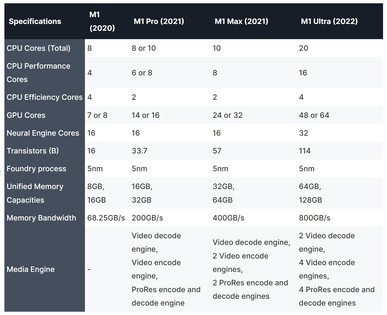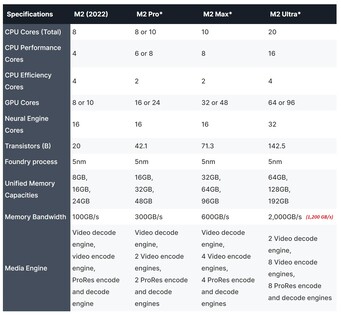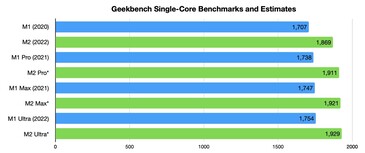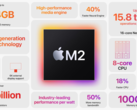Now Apple has unleashed its M2 SoC there have already been attempts at guessing the specifications and capabilities of the rest of the M2 family, which at this point could be fairly guessed at being the future M2 Pro, M2 Max, and M2 Ultra processors. AppleInsider’s Malcolm Owen has had a detailed crack at breaking down the data to come up with potential specifications for the M2 series, although definitely a large pinch of salt is required for certain parts, especially the benchmark guesswork that is based on an alleged M2 test sourced from an unreliable site. However, Owen has actually been quite restrained and even rounded down “unfeasible” figures for credibility.
It's worth noting that the data for the M2 Pro, M2 Max, and M2 Ultra shown in the table below presumes that the chips are produced on a 5 nm manufacturing process. It has already been reported that the M2 Pro could be fabricated on a 3 nm node, and if this is the case then even more impressive specifications could be expected thanks to the improved process. The M2 family mirrors the respective M1 counterparts in terms of CPU core count and performance/efficiency core count, with the argument based on both the M1 and M2 SoCs having the same CPU configuration. Neural engine core count also remains the same, but things start looking up with GPU core counts.
There is a chance the M2 Pro, M2 Max, and M2 Ultra will retain the higher amount of GPU cores as their M1 relatives, but there may also be an increase, with the M2 Pro potentially sporting up to 24 GPU cores, the M2 Max boasting of up to 48 GPU cores, and the M2 Ultra positively astounding everyone with up to 96 GPU cores (understandably double whatever the M2 Max get). Memory specs also get some refined boosts until you hit the M2 Ultra, which blows the M1 Ultra’s 800 GB/s memory bandwidth away by managing up to 1,200 GB/s data transfer rates. The AppleInsider table actually states “2,000 GB/s” for the top-end M2 SoC, but this appears to be a typo, as the source extrapolates the figures by adding 46% (difference between M1 and M2) on top of the M1 Ultra’s performance.
Unsurprisingly, there are also considerable rises in transistor count, memory capacity, and media engine capabilities, with the potential Apple M2 Ultra’s media engine being able to power eight video encode engines and eight ProRes encode and decode engines. As for the hypothetical Geekbench benchmark performances, the M2 Ultra whips the M1 Ultra with +10% and a whopping +20% improvement in single-core and multi-core testing, respectively. Although this is all speculation, there are signs that the M2 generation of Apple silicon will simply reinforce the company’s decision to go out on its own in regard to processor design.
Source(s)
AppleInsider (& tables)






























